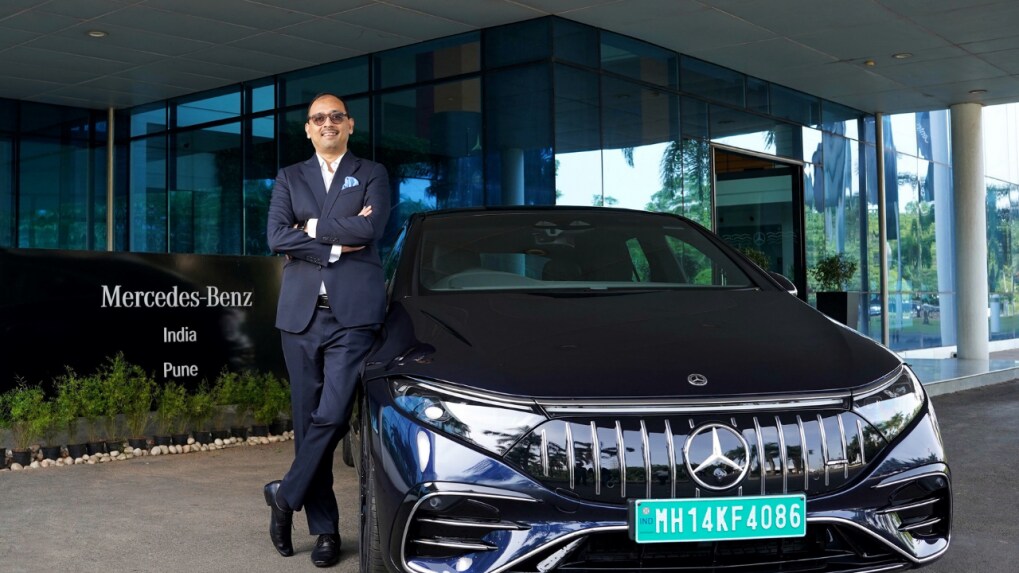EVolve 2022: 'EV campaigns are more avant garde,' says Mercedes-Benz’s Santosh Iyer
Iyer talks about cracking the EV market, understanding the customers and addressing larger industry issues like the EV fires.
ADVERTISEMENT
Barely two years after launching its first EQC (battery electric compact luxury crossover SUV) in India, luxury auto giant Mercedes-Benz is looking to rapidly expand its electric vehicle footprint.
At the centre of its electric future is a well thought-out marketing strategy where the automaker is creating awareness, intrigue and interest amongst customers about EVs while also indulging in friendly banter with competition and growing the EV category in India.
Some of the notable campaigns by the company include #SwitchtoEQC where Mercedes talks about how quiet its EVs can be or the welcome campaign it did during its competition Jaguar’s iPace launch in India.
In an exclusive conversation with Storyboard18, Santosh Iyer, who was recently elevated to MD and CEO of Mercedes-Benz India, talks about cracking the EV market, understanding the customers and larger industry issues including EV fire incidents.
Edited excerpts.
How is your marketing strategy evolving when it comes to EV marketing?
Our integrated marketing strategy for EQC aimed at inspiring our customers to embrace ‘sustainable luxury mobility’ and become early adopters with the EQC - India’s first luxury EV. EQC marketing strategy combined with the unique product attributes, created a strong awareness, drove curiosity about luxury EVs and their practicality in daily usage and firmly established loyal brand advocates for our upcoming EV portfolio. There is an increased acceptability for a luxury EV amongst our customers nowadays compared to even three years back.
How is EV marketing different from conventional auto marketing and advertising?
The EV campaigns are for a more tech-savvy, younger audience and focus on social media. For instance, our recent campaign on EV highlighted the “Magical Garage” concept, which showcased our prowess in technology and innovations, while driving the story of Mercedes-EQ with a creative twist.
Our EV campaigns are tailored to be unconventional, modular and directly targets the respective customer group. These campaigns are a lot more visual and avant garde than most other campaigns.
How is EV marketing different for luxury customers?
Marketing a luxury EV is kind of similar to marketing a top-end luxury vehicle as the focus remains on individual requirements and brand experience desired from the brand. As most of our EV customers are also owners of a Mercedes-Benz, the brand trust and recall is quite high.
For a luxury EV customer, the marketing approach combines offering sustainable mobility with an emotional appeal and luxury brand experience synonymous with Mercedes-Benz. With our brand campaign and retail marketing approach we showcased the EV with its world-class products attributes along with an EQ ecosystem that promises hassle-free ownership devoid of issues like range anxiety, charging infra, etc.
Attributes like sustainable driving, zero emission, reduced carbon footprint, latest technology onboard, a hassle-free ownership etc, are highlighted through our marketing campaigns
What do EV customers look for in EVs and brands? What are their barriers to entry?
These EV customers look for foresight, pioneering spirit and unconventional approaches from brands they want to own or associate with. They look for innovation, pioneering technology and sustainability from an iconic brand like Mercedes-Benz all these characteristics reflect in their individual choices and beliefs
Barriers for these customers can still be in the form of very high prices to an extent and the limited choice of products available currently. However, we are striving to change that with our EQ model portfolio as we plan to introduce the EQS and EQB luxury EVs by 2022.
Based on their preferences and persona, our EV campaigns are tailored to be unconventional, modular and directly targets the respective customer group. These campaigns are a lot more visual and avant garde than most other campaigns.
What are the key challenges that EV makers are facing in India?
High duty of the cars remains a strong deterrent for wider adoption of luxury EVs. However, the long range of our EQ models (EQS range is 770 Kms) alleviates any range anxiety even for inter-city travel. With localization of EQS we also aim for an attractive positioning of the flagship luxury EV in the market.
However, the EV customer will still demand a robust, hassle-free charging infrastructure and an EV ecosystem.
EVs are garnering a lot of negative publicity owing to vehicles catching fire and exploding. How do you deal with such issues as an industry?
These issues are surely concerning and regulations have to be in place regarding safety and security safeguarding the end customers’ requirements.
As OEMs (original equipment manufacturers), we have to introduce products in the market which are of world-class quality featuring the latest in-car technology, most efficient powertrains, powered by high-performance battery technology and having robust structural integrity, to ensure overall safety of passengers remain, totally uncompromised.
Note to readers: The last decade has witnessed significant advances in mobility and transport. New technologies and opportunities have brought a dramatic change to our societies. Planet and people-friendly transportation is more relevant than ever in the history of humankind, with everything from health to climate crises hitting us at warp speed. Storyboard18’s Month In This - EVolve 2022: Building an electric future, is an opportunity to bring to the forefront conversations around charging up marketing and brand building, to exchange and share new ideas, challenges and solutions in the field of clean transportation and mobility. Catch this Storyboard18 special on Moneycontrol, CNBC-TV18 and Forbes India.

